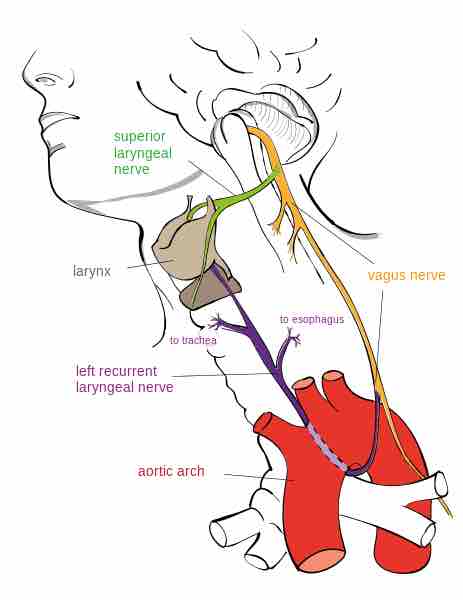Vagus Nerve Anatomy
The vagus nerve, also known as the pneumogastric nerve or cranial nerve X, is the tenth of twelve paired cranial nerves. Upon leaving the medulla between the medullary pyramid and the inferior cerebellar peduncle, it extends through the jugular foramen, then passes into the carotid sheath between the internal carotid artery and the internal jugular vein below the head, to the neck, chest and abdomen, where it contributes to the innervation of the viscera.
Besides output to the various organs in the body, the vagus nerve conveys sensory information about the state of the body's organs to the central nervous system. Eighty to 90% of the nerve fibers in the vagus nerve are afferent (sensory) nerves that communicate the state of the viscera to the brain.

Vagus nerve
Diagram demonstrating the course of the vagus nerve.
The vagus nerve includes axons that emerge from or converge onto four nuclei of the medulla.
- The dorsal nucleus of vagus nerve: Sends parasympathetic output to the viscera, especially the intestines.
- The nucleus ambiguus: Sends parasympathetic output to the heart (slowing it down).
- The solitary nucleus: Receives afferent taste information and primary afferents from visceral organs.
- The spinal trigeminal nucleus: Receives information about deep/crude touch, pain, and temperature of the outer ear, the dura of the posterior cranial fossa, and the mucosa of the larynx.
Function
The vagus nerve supplies motor parasympathetic fibers to all the organs, except the suprarenal (adrenal) glands, from the neck down to the second segment of the transverse colon. The vagus also controls a few skeletal muscles, most notably:
- Cricothyroid muscle.
- Levator veli palatini muscle.
- Salpingopharyngeus muscle.
- Palatoglossus muscle.
- Palatopharyngeus muscle.
- Superior, middle, and inferior pharyngeal constrictors.
- Muscles of the larynx (speech).
This means that the vagus nerve is responsible for such varied tasks as heart rate, gastrointestinal peristalsis, sweating, and quite a few muscle movements in the mouth, including speech (via the recurrent laryngeal nerve), swallowing, and keeping the larynx open for breathing (via action of the posterior cricoarytenoid muscle, the only abductor of the vocal folds).
It also has some afferent fibers that innervate the inner (canal) portion of the outer ear, via the auricular branch (also known as Alderman's nerve) and part of the meninges. This explains why a person may cough when tickled on the ear (such as when trying to remove ear wax with a cotton swab).
Afferent vagus nerve fibers that innervate the pharynx and back of the throat are responsible for the gag reflex. In addition, 5-HT3 receptor-mediated afferent vagus stimulation in the gut due to gastroenteritis and other insults is a cause of vomiting.
Cardiovascular Influence
Parasympathetic innervation of the heart is partially controlled by the vagus nerve and is shared by the thoracic ganglia. Activation of the vagus nerve typically leads to a reduction in heart rate and/or blood pressure.
This occurs commonly in cases of viral gastroenteritis , acute cholecystitis, or in response to stimuli such as the Valsalva maneuver or pain. Excessive activation of the vagal nerve during emotional stress can also cause vasovagal syncope due to a sudden drop in cardiac output, causing cerebral hypoperfusion.